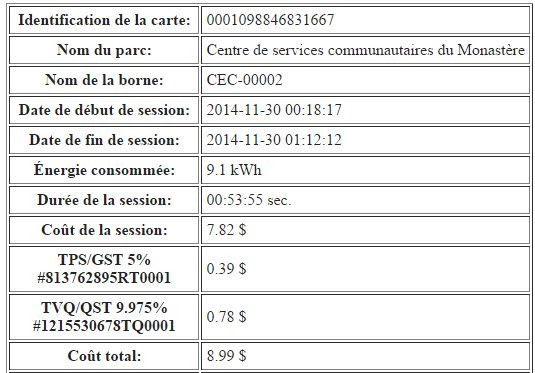sandange
Well-known member
My first cold weather -13 C ( 8 F) fast charging was disappointing
I'll be using fast charging only for emergency in the winter
My Charging report
I just drove 85 km ( 53 miles ) so the battery was warm.
I waited 15 minutes for an I 3 to finish charging
There were 12 km ( 7.5 miles )on the RR gauge
Charged to 77 km ( 48 miles )
It is in French but the main details are understandable
Keep in mind that here our residential electricity cost
are less than .10 kwh
My Circuit Electric charging session
Nom du parc: Centre de services communautaires du Monastère
Nom de la borne: CEC-00002
Date de début de session: 2014-12-30 10:03:55
Date de fin de session: 2014-12-30 10:53:31
Énergie consommée: 8.6 kWh
Durée de la session: 00:49:35 sec.
Coût de la session: 7.19 $
TPS/GST 5%#813762895RT0001 0.36 $
TVQ/QST 9.975%#1215530678TQ0001 0.72 $
Coût total: 8.27 $
I'll be using fast charging only for emergency in the winter
My Charging report
I just drove 85 km ( 53 miles ) so the battery was warm.
I waited 15 minutes for an I 3 to finish charging
There were 12 km ( 7.5 miles )on the RR gauge
Charged to 77 km ( 48 miles )
It is in French but the main details are understandable
Keep in mind that here our residential electricity cost
are less than .10 kwh
My Circuit Electric charging session
Nom du parc: Centre de services communautaires du Monastère
Nom de la borne: CEC-00002
Date de début de session: 2014-12-30 10:03:55
Date de fin de session: 2014-12-30 10:53:31
Énergie consommée: 8.6 kWh
Durée de la session: 00:49:35 sec.
Coût de la session: 7.19 $
TPS/GST 5%#813762895RT0001 0.36 $
TVQ/QST 9.975%#1215530678TQ0001 0.72 $
Coût total: 8.27 $

















